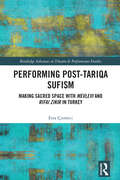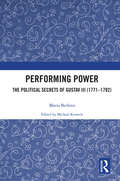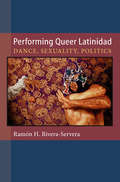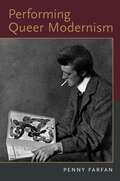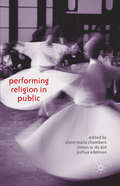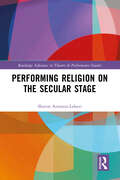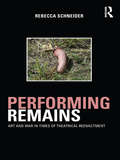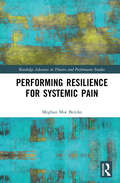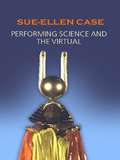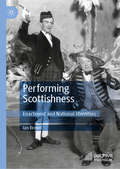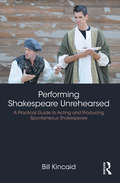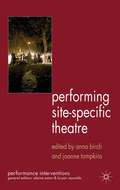- Table View
- List View
Performing Post-Tariqa Sufism: Making Sacred Space with Mevlevi and Rifai Zikir in Turkey (Routledge Advances in Theatre & Performance Studies)
by Esra ÇizmeciThis ethnographic research project examines the generation of post-tariqa Tasavvuf (Sufism: a spiritual practice and philosophy recognised as the inner dimension of Islam) in a variety of private, semi-public, public, secular and sacred urban spaces in present-day Turkey. Through extensive field research in minority Sufi communities, this book investigates how devotees of specific orders maintain, adapt, mobilise, and empower their beliefs and values through embodied acts of their Sufi followers. Using an ethnographic methodology and theories derived from performance studies, Esra Çizmeci examines the multiple ways in which the post-tariqa Mevlevi and Rifai practice is formed in present-day Turkey, such as through the authority of the spiritual teacher; the individual and collective performance of Sufi rituals; nefs (self) training; and, most importantly, the practice of Sufi doctrines in everyday life through the production of sacred spaces. Drawing on the theories of performance, she examines how the Sufi way of living and spaces are created anew in the process of each devotee’s embodied action. This book is informed by theories in performance studies, anthropology, religious studies, and cultural studies and places current Sufi practices in a historical perspective.
Performing Power: The Political Secrets of Gustav III (1771-1792)
by Maria BerlovaPerforming Power explores 18th-century fabrication of the royal image by focusing on the example of King Gustav III (1746–1792) – one of Sweden’s most acclaimed and controversial monarchs – who conspicuously chose theater as the primary media for his image-making and role construction. The text postulates that Gustav III was motivated by theater’s ability to aid him in fulfilling Enlightenment’s tenet of broadly educating the populace and inculcating it with royal ideology. That he was an amateur actor, stage director, and playwright were other engines driving his choice. The project challenges and expands the commonly accepted perception of Gustav III’s contribution to Swedish theater, which has generally been limited to founding its National Opera, developing its national drama, and forming its national dramatic repertoire. Maria Berlova presents Gustav III as a performing King who strategically used political events as a framework through which he could embody the image of the ideal or enlightened monarch as presented by Voltaire. Through this, Performing Power explores the tight relationship and complex bond between theatrical arts and politics. This unique study will be of great interest to students and scholars in theater studies, 18th-century culture, and politics.
Performing Power: The Political Secrets of Gustav III (1771-1792)
by Maria BerlovaPerforming Power explores 18th-century fabrication of the royal image by focusing on the example of King Gustav III (1746–1792) – one of Sweden’s most acclaimed and controversial monarchs – who conspicuously chose theater as the primary media for his image-making and role construction. The text postulates that Gustav III was motivated by theater’s ability to aid him in fulfilling Enlightenment’s tenet of broadly educating the populace and inculcating it with royal ideology. That he was an amateur actor, stage director, and playwright were other engines driving his choice. The project challenges and expands the commonly accepted perception of Gustav III’s contribution to Swedish theater, which has generally been limited to founding its National Opera, developing its national drama, and forming its national dramatic repertoire. Maria Berlova presents Gustav III as a performing King who strategically used political events as a framework through which he could embody the image of the ideal or enlightened monarch as presented by Voltaire. Through this, Performing Power explores the tight relationship and complex bond between theatrical arts and politics. This unique study will be of great interest to students and scholars in theater studies, 18th-century culture, and politics.
Performing Psychologies: Imagination, Creativity and Dramas of the Mind (Performance and Science: Interdisciplinary Dialogues)
by Philip Barnard Nicola ShaughnessyPerforming Psychologies offers new perspectives on arts and health, focussing on the different ways in which performance interacting with psychology can enhance understanding of the mind. The book challenges stereotypes of disability, madness and creativity, addressing a range of conditions (autism, dementia and schizophrenia) and performance practices including staged productions and applied work in custodial, health and community settings.Featuring case studies ranging from Hamlet to The Curious Incident of the Dog in the Night-Time, the pioneering work of companies such as Spare Tyre and Ridiculusmus, and embracing dance and music as well as theatre and drama, the volume offers new perspectives on the dynamic interactions between performance, psychology and states of mind. It contains contributions from psychologists, performance scholars, therapists and healthcare professionals, who offer multiple perspectives on working through performance-based media. Presenting a richly interdisciplinary and collaborative investigation of the arts in practice, this volume opens up new ways of thinking about the performance of psychologies, and about how psychologies perform.
Performing Psychologies: Imagination, Creativity and Dramas of the Mind (Performance and Science: Interdisciplinary Dialogues)
by Nicola Shaughnessy Philip BarnardPerforming Psychologies offers new perspectives on arts and health, focussing on the different ways in which performance interacting with psychology can enhance understanding of the mind. The book challenges stereotypes of disability, madness and creativity, addressing a range of conditions (autism, dementia and schizophrenia) and performance practices including staged productions and applied work in custodial, health and community settings.Featuring case studies ranging from Hamlet to The Curious Incident of the Dog in the Night-Time, the pioneering work of companies such as Spare Tyre and Ridiculusmus, and embracing dance and music as well as theatre and drama, the volume offers new perspectives on the dynamic interactions between performance, psychology and states of mind. It contains contributions from psychologists, performance scholars, therapists and healthcare professionals, who offer multiple perspectives on working through performance-based media. Presenting a richly interdisciplinary and collaborative investigation of the arts in practice, this volume opens up new ways of thinking about the performance of psychologies, and about how psychologies perform.
Performing Queer Latinidad: Dance, Sexuality, Politics (Triangulations: Lesbian/Gay/Queer Theater/Drama/Performance)
by Ramon Rivera-ServeraPerforming Queer Latinidad highlights the critical role that performance played in the development of Latina/o queer public culture in the United States during the 1990s and early 2000s, a period when the size and influence of the Latina/o population was increasing alongside a growing scrutiny of the public spaces where latinidad could circulate. Performances---from concert dance and street protest to the choreographic strategies deployed by dancers at nightclubs---served as critical meeting points and practices through which LGBT and other nonnormative sex practitioners of Latin American descent (individuals with greatly differing cultures, histories of migration or annexation to the United States, and contemporary living conditions) encountered each other and forged social, cultural, and political bonds. At a time when latinidad ascended to the national public sphere in mainstream commercial and political venues and Latina/o public space was increasingly threatened by the redevelopment of urban centers and a revived anti-immigrant campaign, queer Latinas/os in places such as the Bronx, San Antonio, Austin, Phoenix, and Rochester, NY, returned to performance to claim spaces and ways of being that allowed their queerness and latinidad to coexist. These social events of performance and their attendant aesthetic communication strategies served as critical sites and tactics for creating and sustaining queer latinidad.
Performing Queer Modernism
by Penny FarfanFocusing on some of the best-known and most visible stage plays and dance performances of the late nineteenth- and early twentieth-centuries, Penny Farfan's interdisciplinary study demonstrates that queer performance was integral to and productive of modernism, that queer modernist performance played a key role in the historical emergence of modern sexual identities, and that it anticipated, and was in a sense foundational to, the insights of contemporary queer modernist studies. Chapters on works from Vaslav Nijinsky's Afternoon of a Faun to Noël Coward's Private Lives highlight manifestations of and suggest ways of reading queer modernist performance. Together, these case studies clarify aspects of both the queer and the modernist, and how their co-productive intersection was articulated in and through performance on the late-nineteenth- and early-twentieth-century stage. Performing Queer Modernism thus contributes to an expanded understanding of modernism across a range of performance genres, the central role of performance within modernism more generally, and the integral relation between performance history and the history of sexuality. It also contributes to the ongoing transformation of the field of modernist studies, in which drama and performance remain under-represented, and to revisionist historiographies that approach modernist performance through feminist and queer critical perspectives and interdisciplinary frameworks and that consider how formally innovative as well as more conventional works collectively engaged with modernity, at once reflecting and contributing to historical change in the domains of gender and sexuality.
PERFORMING QUEER MODERNISM C
by Penny FarfanFocusing on some of the best-known and most visible stage plays and dance performances of the late nineteenth- and early twentieth-centuries, Penny Farfan's interdisciplinary study demonstrates that queer performance was integral to and productive of modernism, that queer modernist performance played a key role in the historical emergence of modern sexual identities, and that it anticipated, and was in a sense foundational to, the insights of contemporary queer modernist studies. Chapters on works from Vaslav Nijinsky's Afternoon of a Faun to Noël Coward's Private Lives highlight manifestations of and suggest ways of reading queer modernist performance. Together, these case studies clarify aspects of both the queer and the modernist, and how their co-productive intersection was articulated in and through performance on the late-nineteenth- and early-twentieth-century stage. Performing Queer Modernism thus contributes to an expanded understanding of modernism across a range of performance genres, the central role of performance within modernism more generally, and the integral relation between performance history and the history of sexuality. It also contributes to the ongoing transformation of the field of modernist studies, in which drama and performance remain under-represented, and to revisionist historiographies that approach modernist performance through feminist and queer critical perspectives and interdisciplinary frameworks and that consider how formally innovative as well as more conventional works collectively engaged with modernity, at once reflecting and contributing to historical change in the domains of gender and sexuality.
Performing Race and Erasure: Cuba, Haiti, and US Culture, 1898–1940 (Palgrave Studies in Theatre and Performance History)
by Shannon Rose RileyIn this book, Shannon Rose Riley provides a critically rich investigation of representations of Cuba and Haiti in US culture in order to analyze their significance not only to the emergence of empire but especially to the reconfiguration of US racial structures along increasingly biracial lines. Based on impressive research and with extensive analysis of various textual and performance forms including a largely unique set of skits, plays, songs, cultural performances and other popular amusements, Riley shows that Cuba and Haiti were particularly meaningful to the ways that people in the US re-imagined themselves as black or white and that racial positions were renegotiated through what she calls acts of palimpsest: marking and unmarking, racing and erasing difference. Riley’s book demands a reassessment of the importance of the occupations of Cuba and Haiti to US culture, challenging conventional understandings of performance, empire, and race at the turn of the twentieth century.
Performing Religion in Public
by Claire Maria Chambers, Simon W. du Toit and Joshua EdelmanReligious life and public life are both passionately performed, but often understood to exclude one another. This book's array of voices investigates the publics hailed by religious performances and the challenges they offer to theories of the democratic public sphere.
Performing Religion on the Secular Stage (Routledge Advances in Theatre & Performance Studies)
by Sharon Aronson-LehaviThis book examines the relations between Western religion, secularism, and modern theater and performance. Sharon Aronson-Lehavi posits that the ongoing cultural power of religious texts, icons, and ideas on the one hand and the artistic freedom enabled by secularism and avant-garde experimentalism on the other, has led theatre artists throughout the twentieth century to create a uniquely modern theatrical hybrid–theater performances that simultaneously re-inscribe and grapple with religion and religious performativity. The book compares this phenomenon with medieval forms of religious theater and offers deep and original analyses of significant contemporary works ranging from plays and performances by August Strindberg, Hugo Ball (Dada), Jerzy Grotowski, and Hanoch Levin, to those created by Adrienne Kennedy, Rina Yerushalmi, Deb Margolin, Milo Rau, and Sarah Ruhl. The book analyzes a new and original historiography of a uniquely modern theatrical phenomenon, a study that is of high importance considering the reemergence of religion in contemporary culture and politics.
Performing Religion on the Secular Stage (Routledge Advances in Theatre & Performance Studies)
by Sharon Aronson-LehaviThis book examines the relations between Western religion, secularism, and modern theater and performance. Sharon Aronson-Lehavi posits that the ongoing cultural power of religious texts, icons, and ideas on the one hand and the artistic freedom enabled by secularism and avant-garde experimentalism on the other, has led theatre artists throughout the twentieth century to create a uniquely modern theatrical hybrid–theater performances that simultaneously re-inscribe and grapple with religion and religious performativity. The book compares this phenomenon with medieval forms of religious theater and offers deep and original analyses of significant contemporary works ranging from plays and performances by August Strindberg, Hugo Ball (Dada), Jerzy Grotowski, and Hanoch Levin, to those created by Adrienne Kennedy, Rina Yerushalmi, Deb Margolin, Milo Rau, and Sarah Ruhl. The book analyzes a new and original historiography of a uniquely modern theatrical phenomenon, a study that is of high importance considering the reemergence of religion in contemporary culture and politics.
Performing Remains: Art and War in Times of Theatrical Reenactment
by Rebecca Schneider'At last, the past has arrived! Performing Remains is Rebecca Schneider's authoritative statement on a major topic of interest to the field of theatre and performance studies. It extends and consolidates her pioneering contributions to the field through its interdisciplinary method, vivid writing, and stimulating polemic. Performing Remains has been eagerly awaited, and will be appreciated now and in the future for its rigorous investigations into the aesthetic and political potential of reenactments.' - Tavia Nyong'o, Tisch School of the Arts, New York University 'I have often wondered where the big, important, paradigm-changing book about re-enactment is: Schneider’s book seems to me to be that book. Her work is challenging, thoughtful and innovative and will set the agenda for study in a number of areas for the next decade.' - Jerome de Groot, University of Manchester Performing Remains is a dazzling new study exploring the role of the fake, the false and the faux in contemporary performance. Rebecca Schneider argues passionately that performance can be engaged as what remains, rather than what disappears. Across seven essays, Schneider presents a forensic and unique examination of both contemporary and historical performance, drawing on a variety of elucidating sources including the "America" plays of Linda Mussmann and Suzan-Lori Parks, performances of Marina Abramovic´ and Allison Smith, and the continued popular appeal of Civil War reenactments. Performing Remains questions the importance of representation throughout history and today, while boldly reassessing the ritual value of failure to recapture the past and recreate the "original."
Performing Remains: Art and War in Times of Theatrical Reenactment
by Rebecca Schneider'At last, the past has arrived! Performing Remains is Rebecca Schneider's authoritative statement on a major topic of interest to the field of theatre and performance studies. It extends and consolidates her pioneering contributions to the field through its interdisciplinary method, vivid writing, and stimulating polemic. Performing Remains has been eagerly awaited, and will be appreciated now and in the future for its rigorous investigations into the aesthetic and political potential of reenactments.' - Tavia Nyong'o, Tisch School of the Arts, New York University 'I have often wondered where the big, important, paradigm-changing book about re-enactment is: Schneider’s book seems to me to be that book. Her work is challenging, thoughtful and innovative and will set the agenda for study in a number of areas for the next decade.' - Jerome de Groot, University of Manchester Performing Remains is a dazzling new study exploring the role of the fake, the false and the faux in contemporary performance. Rebecca Schneider argues passionately that performance can be engaged as what remains, rather than what disappears. Across seven essays, Schneider presents a forensic and unique examination of both contemporary and historical performance, drawing on a variety of elucidating sources including the "America" plays of Linda Mussmann and Suzan-Lori Parks, performances of Marina Abramovic´ and Allison Smith, and the continued popular appeal of Civil War reenactments. Performing Remains questions the importance of representation throughout history and today, while boldly reassessing the ritual value of failure to recapture the past and recreate the "original."
Performing Remembering: Women's Memories of War in Vietnam (Contemporary Performance InterActions)
by Rivka Syd EisnerThis book explores the performances and politics of memory among a group of women war veterans in Ho Chi Minh City, Vietnam. Through ethnographic, oral history-based research, it connects the veterans’ wartime histories, memory politics, performance practices, recollections of imprisonment and torture, and social activism with broader questions of how to understand and attend to continuing transgenerational violence and trauma. With an extensive introduction and subsequent chapters devoted to in-depth analysis of four women’s remarkable life stories, the book explores the performance and performativity of culture; ethnographic oral history practice; personal, collective, and (trans)cultural memory; and the politics of postwar trauma, witnessing, and redress. Through the veterans’ dynamic practices of prospective remembering, 'pain-taking', and enduring optimism, it offers new insights into matrices of performance vital to the shared work of social transformation. It will appeal to readers interested in performance studies, memory studies, gender studies, Vietnamese studies, and oral history.
Performing Remembering: Women's Memories of War in Vietnam (Contemporary Performance InterActions)
by Rivka Syd EisnerThis book explores the performances and politics of memory among a group of women war veterans in Ho Chi Minh City, Vietnam. Through ethnographic, oral history-based research, it connects the veterans’ wartime histories, memory politics, performance practices, recollections of imprisonment and torture, and social activism with broader questions of how to understand and attend to continuing transgenerational violence and trauma. With an extensive introduction and subsequent chapters devoted to in-depth analysis of four women’s remarkable life stories, the book explores the performance and performativity of culture; ethnographic oral history practice; personal, collective, and (trans)cultural memory; and the politics of postwar trauma, witnessing, and redress. Through the veterans’ dynamic practices of prospective remembering, 'pain-taking', and enduring optimism, it offers new insights into matrices of performance vital to the shared work of social transformation. It will appeal to readers interested in performance studies, memory studies, gender studies, Vietnamese studies, and oral history.
Performing Resilience for Systemic Pain (Routledge Advances in Theatre & Performance Studies)
by Meghan Moe BeitiksHow might performance serve as a means for facing ubiquitous trauma and pain, in humans and ecologies? While reflecting on her multidisciplinary work Systems of Pain/Networks of Resilience, artist Meghan Moe Beitiks considers bodies of knowledge in Trauma Theory, Intersectional Feminist Philosophy, Ecology, Disability Studies, New Materialism, Object-Oriented Ontology, Gender Studies, Artistic Research, Psychology, Performance Studies, Social Justice, Performance Philosophy, Performance Art, and a series of first-person interviews in an attempt to answer that question. Beitiks brings us through the first-person process of making the work and the real-life, embodied encounters with the theories explored within it as an expansion of the work itself. Facing down difficult issues like trauma, discrimination, and the vulnerability of the body, Beitiks looks to commonalities across species and disciplines as means of developing resilience and cultivating communities. Rather than paint a picture of glorious potential utopias, Beitiks takes a hard look at herself as an embodiment of the values explored in the work, and stays with the difficult, sucky, troubling, work to be done. Performing Resilience for Systemic Pain is a vulnerable book about the quiet presence and hard looking needed to shift systems away from their oppressive, destructive realities.
Performing Resilience for Systemic Pain (Routledge Advances in Theatre & Performance Studies)
by Meghan Moe BeitiksHow might performance serve as a means for facing ubiquitous trauma and pain, in humans and ecologies? While reflecting on her multidisciplinary work Systems of Pain/Networks of Resilience, artist Meghan Moe Beitiks considers bodies of knowledge in Trauma Theory, Intersectional Feminist Philosophy, Ecology, Disability Studies, New Materialism, Object-Oriented Ontology, Gender Studies, Artistic Research, Psychology, Performance Studies, Social Justice, Performance Philosophy, Performance Art, and a series of first-person interviews in an attempt to answer that question. Beitiks brings us through the first-person process of making the work and the real-life, embodied encounters with the theories explored within it as an expansion of the work itself. Facing down difficult issues like trauma, discrimination, and the vulnerability of the body, Beitiks looks to commonalities across species and disciplines as means of developing resilience and cultivating communities. Rather than paint a picture of glorious potential utopias, Beitiks takes a hard look at herself as an embodiment of the values explored in the work, and stays with the difficult, sucky, troubling, work to be done. Performing Resilience for Systemic Pain is a vulnerable book about the quiet presence and hard looking needed to shift systems away from their oppressive, destructive realities.
Performing Ruins (Performing Landscapes)
by Simon MurrayThis book engages with the relationship between ruins, dilapidation, and abandonment and cultural events performed within such spaces. Following the author’s fieldwork in the UK, Bosnia Herzegovina, Poland, Germany, Greece, and Sicily, chapters describe, investigate, and reflect upon live performance events which have taken place in sites of decay and abandonment. The book’s main focus is upon modern economic ruins and ruins of warfare. Each chapter provides several case studies based upon the author’s own site visits and interviews with actors, directors, producers, curators, writers, and other artists. The book contextualises these events within the wider framework of Ruin Studies and provides brief summaries of how we might understand the ruin in terms of time, politics, culture, and atmospheres. The book is particularly preoccupied with artists’ reasons and motivations for placing performance events in ruined spaces and how these work dramaturgically.
Performing Science and the Virtual
by Sue-Ellen CaseThis impressive new book from Sue-Ellen Case looks at how science has been performed throughout history, tracing a line from nineteenth century alchemy to the twenty-first century virtual avatar. In this bold and wide-ranging book that is written using a crossbreed of styles, we encounter a glance of Edison in his laboratory, enter the soundscape of John Cage and raid tombs with Lara Croft. Case looks at the intersection of science and performance, the academic treatment of classical plays and internet-like bytes on contemporary issues and experiments where the array of performances include: electronic music Sun Ra, the jazz musician the recursive play of tape from Samuel Beckett to Pauline Oliveros Performing Science and the Virtual reviews how well these performances borrow from spiritualist notions of transcendence, as well as the social codes of race, gender and economic exchange. This book will appeal to academics and graduates studying theatre and performance studies, cultural studies and philosophy.
Performing Science and the Virtual
by Sue-Ellen CaseThis impressive new book from Sue-Ellen Case looks at how science has been performed throughout history, tracing a line from nineteenth century alchemy to the twenty-first century virtual avatar. In this bold and wide-ranging book that is written using a crossbreed of styles, we encounter a glance of Edison in his laboratory, enter the soundscape of John Cage and raid tombs with Lara Croft. Case looks at the intersection of science and performance, the academic treatment of classical plays and internet-like bytes on contemporary issues and experiments where the array of performances include: electronic music Sun Ra, the jazz musician the recursive play of tape from Samuel Beckett to Pauline Oliveros Performing Science and the Virtual reviews how well these performances borrow from spiritualist notions of transcendence, as well as the social codes of race, gender and economic exchange. This book will appeal to academics and graduates studying theatre and performance studies, cultural studies and philosophy.
Performing Scottishness: Enactment and National Identities
by Ian BrownThis wide-ranging and ground-breaking book, especially relevant given Brexit and renewed Scottish independence campaigning, provides in-depth analysis of ways Scottishness has been performed and modified over the centuries. Alongside theatre, television, comedy, and film, it explores performativity in public events, Anglo-Scottish relations, language and literary practice, the Scottish diaspora and concepts of nation, borders and hybridity. Following discussion of the 1320 Declaration of Arbroath and the real meanings of the 1706/7 Treaty of Union, it examines the differing perceptions of what the ‘United Kingdom’ means to Scots and English. It contrasts the treatment of Shakespeare and Burns as ‘national bards’ and considers the implications of Scottish scholars’ invention of ‘English Literature’. It engages with Scotland’s language politics –rebutting claims of a ‘Gaelic Gestapo’ – and how borders within Scotland interact. It replaces myths about ‘tartan monsters’ with level-headed evidence before discussing in detail representations of Scottishness in domestic and international media.
Performing Shakespeare Unrehearsed: A Practical Guide to Acting and Producing Spontaneous Shakespeare
by Bill KincaidPerforming Shakespeare Unrehearsed: A Practical Guide to Acting and Producing Spontaneous Shakespeare outlines how Shakespeare’s plays can be performed effectively without rehearsal, if all the actors understand a set of performance guidelines and put them into practice. Each chapter is devoted to a specific guideline, demonstrating through examples how it can be applied to pieces of text from Shakespeare’s First Folio, how it creates blocking and stage business, and how it enhances story clarity. Once the guidelines have been established, practical means of production are discussed, providing the reader with sufficient step-by-step instruction to prepare for Unrehearsed performances. This book is written for the actor and performer.
Performing Shakespeare Unrehearsed: A Practical Guide to Acting and Producing Spontaneous Shakespeare
by Bill KincaidPerforming Shakespeare Unrehearsed: A Practical Guide to Acting and Producing Spontaneous Shakespeare outlines how Shakespeare’s plays can be performed effectively without rehearsal, if all the actors understand a set of performance guidelines and put them into practice. Each chapter is devoted to a specific guideline, demonstrating through examples how it can be applied to pieces of text from Shakespeare’s First Folio, how it creates blocking and stage business, and how it enhances story clarity. Once the guidelines have been established, practical means of production are discussed, providing the reader with sufficient step-by-step instruction to prepare for Unrehearsed performances. This book is written for the actor and performer.
Performing Site-Specific Theatre: Politics, Place, Practice (Performance Interventions)
by Anna Birch & Joanne TompkinsThis book investigates the expanding parameters for site-specific performance to account for the form's increasing popularity in the twenty-first century. Leading practitioners and theorists interrogate issues of performance and site to broaden our understanding of the role that place plays in performance and the ways that performance influences it
